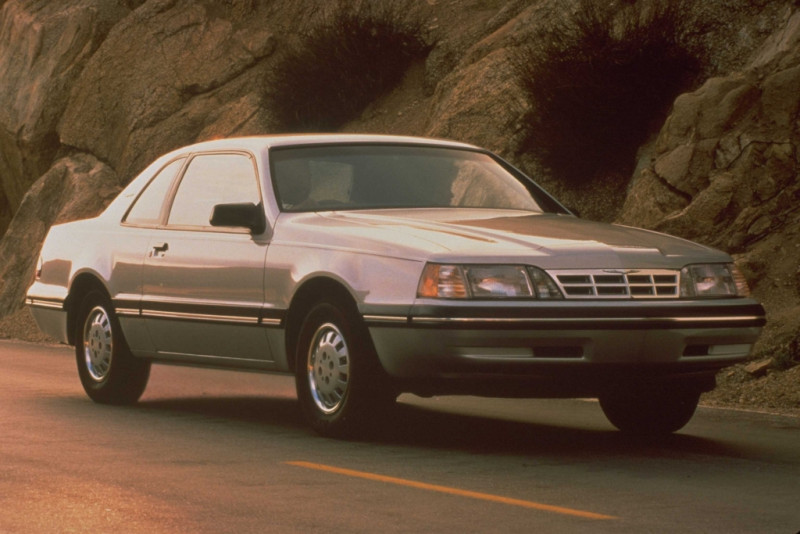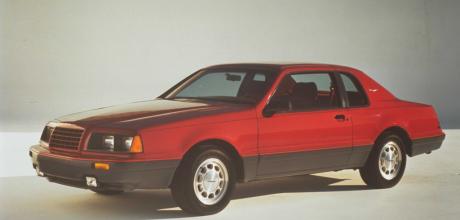Aero hero - Ford’s 1983-1988 Thunderbird ushered in a new era for American cars
Pundits will argue that the 1986 Ford Taurus was the car that really redefined American car design during the Eighties; but I would argue that its Thunderbird stablemate, which debuted three years earlier, was the Detroit automobile that really represented a break from the past. Both designs were penned under the eye of John J ‘Jack’ Telnack, Ford’s vice-president of light car and truck design at the time. Telnack, having spent the early Seventies working in Europe, had very different ideas from what was then prevalent design language in Detroit, and, upon his return to Dearborn, began introducing some of these European design concepts to stateside Ford products.
The first indicators of this – certainly in production vehicles – could be found in the 1978 Ford Fairmont/Mercury Zephyr and the 1979 Ford Mustang/Mercury Capri, with their angular contours, sensible proportions and Euro touches such as fluted tail-lights and louvred quarter window accents. But it was the 1983 Thunderbird that really shook things up. Built atop the Fox platform, which also underpinned its 1980-82 predecessor, and boasting similar mechanicals on the outside, the ’83 T-bird couldn’t have been more radically different. It was sleek, with rounded edges, a beak-like nose, integrated bumper covers and smoothly integrated doors that cut into the roof.
The new T-bird’s aerodynamic efficiency was such that it achieved a drag coefficient of just 0.35, which at the time made it just about the most aerodynamic thing around. Of course there were additional benefits. Besides being a showroom traffic builder, the new shape boosted fuel efficiency and also gave NASCAR teams that ran these cars a competitive edge, especially on the big oval tracks like Charlotte and Talladega. At launch, just two engines were offered, a new 3.8-litre ‘Essex’ pushrod V6, or the venerable 302 cubic inch (5.0-litre) V8. A third option arrived later in the model year, the 2.3-litre ‘Lima’ turbocharged four-cylinder, offered in a new model known as the Turbo Coupe. Also available in that year’s Mustang GT Turbo, this engine was a major reworking of the previous blown four found in 1979-1981 Mustangs. It featured a new multi-port electronic fuel-injection system, with an electronically controlled waste gate for the turbocharger. Boost was set at a maximum of 10psi, while air/fuel delivery was controlled by Ford’s new EEC-IV electronic engine control computer, and in factory tune this new turbo four cranked out 145 horsepower and 180lb-ft of torque.
In the Turbo Coupe, it was offered with a five-speed manual gearbox and Traction-Lok limited-slip differential. So equipped, one of these cars could scoot from 0-60mph in well under nine seconds. With gas-charged dampers, 14-inch road wheels, Goodyear Eagle GT performance radials, dual Marchal foglights and black exterior trim, the Turbo Coupe really looked the business and took to the turns with far greater enthusiasm than any previous Thunderbird. Inside, driver and passenger were treated to adjustable sport bucket seats, with thigh bolsters, full instrumentation and a flowing centre console, with slick shifting gearstick for the five-speed Borg Warner T-5 manual. It’s probably hard to imagine now, but at the time the new Thunderbird, especially the Turbo Coupe, represented nothing short of a revolution in Detroit automotive thinking. It was sleek, sophisticated, and unlike its 1980- 82 predecessor, buyers flocked to it in droves. Nearly 122,000 were sold that first year, while the total bloomed to 170,551 units for ’84. The following year, Thunderbird celebrated its 30th anniversary, with an updated interior and instrument panel, plus a special Anniversary Edition finished in Medium Regatta Blue with contrasting grey and silver accents.
In 1987 there was a major update for the swoopy ninth-generation T-bird. This included a sleeker nose, with flush composite headlamps, bigger tail-light lenses and larger rear quarter window openings. The Turbo Coupe now stood apart from its siblings via a grille-less nose (all the rage at the time), unique 16-inch alloy wheels and a special hood with twin scoops. These were functional and provided air to the intercooler on an improved and fortified 2.3-litre turbo four, which also got a new IHI turbocharger and more boost (up to 15psi). As a result, it now cranked out 190bhp and 240lb-ft of torque, when teamed with the five-speed manual and dual exhausts.
Other new features were four-wheel disc brakes with standard ABS (one of the first mainstream American cars to feature this technology) and a selective ride control function that allowed the driver to adjust damping rates via a console-mounted switch. This new fortified Turbo Coupe was the most fun-to-drive Thunderbird ever built and its appeal and performance was strong enough that it earned Motor Trend’s coveted Car of the Year award for ’87. Additionally, NASCAR star Bill Elliott also made the history books that year when his Thunderbird clocked a record 210.36 miles per hour at Daytona International Speedway. It was a fitting achievement for a car that represented a new direction for Ford Motor Company in the US and a new era for Detroit.
Given that it has now been 40 years since the slick ninth-generation Thunderbird debuted, Classic American salutes the original ‘aero hero’!



